Having a swimming pool in your garden may seem like a luxury that only the more well off can stretch to, however today there are an abundance of DIY swimming pool solutions for all types of gardens.
In this guide, we take a look at the various types of DIY swimming pool and how they are constructed.
Can you Build Your own Swimming Pool?
One question that you might ask yourself, especially in the warm summer months is Can I build my own swimming pool? The short answer is yes, but as with all things, it depends on your budget, skills, and the type of pool you want.
There is a vast array of different types of pools that you can build, over ground, in ground, temporary, ones that you make up yourself, those that you can buy from a shop etc. and depending on which you want to go for, will depend on the the complexity of the build and the work involved.
Do you Need Planning Permission for a Swimming Pool in the UK?
Before you start any form of digging, one question that needs to be answered: Do I need planning permission for a swimming pool in the UK? In most cases, outdoor swimming pools are considered permitted development, meaning you don’t need planning permission. However, there are some exceptions and regulations you do need be aware of.
When Does a Swimming Pool Require Planning Permission?
You will need planning permission if:
- Your home is in a conservation area, listed building, or National Park.
- The pool will be built at the front of your property (not behind or to the side).
- You are planning a large or enclosed structure around the pool.
- The pool construction involves significant excavation or could impact drainage.
Special Considerations for Indoor and Covered Pools
If you’re building an indoor swimming pool (such as in an extension or outbuilding), you may need planning permission if:
- The total area exceeds 50% of your garden space.
- The structure is taller than 4 metres or closer than 2 metres to your boundary.
- You live in a restricted planning zone, such as a Green Belt or Area of Outstanding Natural Beauty (AONB).
How to Check If You Need Planning Permission
As we have said at the top of this section, before a spade is stuck in the ground, even though you may suspect you don’t need planning permission, it’s certainly worth your time checking to make 100% sure. To do so, contact your local authority planning office and discuss your plans with them, they will be able to confirm either way.
Building Regulations and Safety Considerations
Even if planning permission isn’t required, you must by law still follow UK Building Regulations to ensure the construction is done to a specific level and that it is safe, this includes:
- Proper drainage and surface water management.
- Safe electrical installations for lighting and heating.
- Pool safety measures, such as fencing, covers, and non-slip surfaces.
Types of DIY Swimming Pool in the UK
In the UK, there are several different types of swimming pool. The main categories include above-ground pools, in-ground pools and also natural pools. Within each of these categories there are numerous types, the most popular of these are as follows:
Above-Ground Swimming Pools
Above-ground pools are the easiest and most affordable DIY option and great for quick installation and for small gardens. They come in pre-made kits with metal frames or inflatable designs and require minimal groundwork. You simply set them up on a flat, stable surface, such as a patio or reinforced lawn and you’re free to enjoy.
Pros:
- Affordable – Prices start from £500.
- Fast and easy to install.
- No digging or complex construction.
Cons:
- Less durable than in-ground options.
- Limited design and size choices.
- May require additional heating for year-round use.
In-Ground Liner Pools
In-ground liner pools use a flexible vinyl liner placed over a pre-built frame (metal, plastic, or concrete). They are more durable than above-ground pools but cheaper and easier to install than traditional tiled or concrete pools.
Pros:
- More cost-effective than full concrete pools.
- Easier to install than other in-ground pools.
- Customisable sizes and shapes.
Cons:
- Liner needs replacing every 8-12 years.
- Can be damaged by sharp objects.
- Not as durable and long-lasting as tiled or concrete pools.
Fibreglass Pools
Fibreglass pools are pre-moulded shells that are dropped into an excavated hole. They are very durable and quick to install.
They are a popular mid-range option over liner pools due to their durability and also quicker to install than concrete pools.
Pros:
- Faster installation than concrete pools.
- Low maintenance – smooth surface reduces algae growth.
- Strong and long-lasting.
Cons:
- More expensive than liner pools.
- Limited shape and size options.
- Transport and installation require planning.
Concrete and Tiled Pools
Concrete pools offer complete freedom and design flexibility and are by far the most durable option, however due to this, they are also the most labour-intensive and expensive.
The process involves excavation, steel reinforcement, waterproofing, and tiling, which takes several weeks.
Pros:
- Custom-built to any shape or size.
- Extremely durable and long-lasting.
- High-end look with luxury finishes.
Cons:
- Most expensive DIY option (typically £20,000+).
- Requires specialist knowledge and tools.
- Longer installation time.
Natural and Eco Pools
Best for: Chemical-free swimming, wildlife-friendly gardens.
Natural pools use plant-based filtration instead of chlorine or chemicals. They blend seamlessly into garden landscapes and support wildlife, making them a great eco-friendly option.
Pros:
- No harsh chemicals – better for health and environment.
- Blends naturally into garden settings.
- Lower long-term maintenance costs.
Cons:
- Requires a dedicated filtration zone with aquatic plants.
- Water clarity varies with seasons.
- Can be more expensive than traditional pools.
What Distance From a House Does a Swimming Pool Need to Be in the UK?
When planning a swimming pool in your garden, one of the most important factors to consider is its distance from your house.
In the UK, there are no strict nationwide rules on how far a pool must be from a house, but local authority building regulations, drainage concerns, and structural safety all play a role.
Understanding these factors can help you avoid costly mistakes and ensure your pool is built in a safe and practical location.
Although there is no single legal requirement, most experts recommend placing your pool at least 3 to 5 metres from your home. This ensures:
- Protection from potential water damage to your house’s foundations.
- Enough space for poolside drainage and filtration systems.
- Reduced impact on underground utilities such as gas, water, and electrical lines.
How Much Does It Cost to Build and Run a Pool in the UK?
Owning a swimming pool, especially in the summer, is great, however depending on the type of pool you have, it can be quite expensive, so it’s essential to understand the costs involved.
From initial construction to ongoing running costs, the price of having a pool in the UK can vary significantly based on size, type, and maintenance. Below, we break down the costs to help you plan your budget effectively.
How Much Does It Cost to Build a Swimming Pool in the UK?
The total cost of building a swimming pool in the UK depends on factors such as size, materials, and whether you opt for an above-ground or in-ground pool.
| Type of Pool | Estimated Cost | Installation Time |
|---|---|---|
| Above-Ground Pool | £1,500 – £5,000 | 1-3 days |
| In-Ground Vinyl Liner Pool | £10,000 – £25,000 | 2-4 weeks |
| Fibreglass Pool | £20,000 – £40,000 | 2-6 weeks |
| Concrete or Tiled Pool | £30,000 – £100,000+ | 8-16 weeks |
| Natural or Eco Pool | £25,000 – £70,000 | 6-12 weeks |
How Much Does It Cost to Run a Pool in the UK?
Once your pool is built, you need to consider ongoing costs such as heating, filtration, cleaning, and maintenance.
1. Heating Costs
Keeping your pool warm is essential in the UK. The cost depends on the heating method:
- Electric Heat Pump: £500 – £1,500 per year
- Gas Boiler: £800 – £2,000 per year
- Solar Heating: £500 – £1,000 (one-off installation), then minimal running costs
2. Water and Chemical Costs
Maintaining water quality is crucial. Here’s what you can expect to spend:
- Water refills: £100 – £300 per year
- Chemicals (chlorine, pH balancers, algaecide): £300 – £800 per year
3. Filtration and Cleaning
Keeping your pool clean requires regular maintenance:
- Pool pump and filtration: £200 – £800 per year
- Automatic pool cleaner: £500 – £2,000 (one-off cost)
- Professional cleaning service: £50 – £150 per visit
4. Repairs and General Maintenance
Over time, your pool will need repairs and general upkeep:
- Liner replacement (every 10 years): £3,000 – £5,000
- Pump replacement (every 5-10 years): £500 – £1,500
- Tile & surface repairs: £500 – £3,000
Total Annual Running Costs
For a standard in-ground heated pool, annual running costs typically range from £1,500 to £5,000 depending on heating, cleaning, and maintenance needs.
How to Build a DIY Swimming Pool in the UK
Now that we have looked at all the different aspects of what’s involved with constructing and owning a swimming pool in the UK, it’s now time to look at the all important steps involved in how they are actually constructed.
For the purposes of this guide we are going to go through the steps involved in constructing a below ground pool. This is actually a case study provided by the contractors that constructed a poll for a customer of theirs by the name of Gary Searle.
Step 1: Choose the Right Type of DIY Pool
There are several types of pools you can build yourself, each with different levels of complexity and cost, however some require specialist construction techniques so you may prefer to let a specialist pool construction company undertake the work, but firstly, decide on what type of pool you want to go for:
- Above-Ground Pools: The easiest and most affordable option, using pre-made kits or timber framing with a liner.
- Concrete Block Pools: More durable and customisable, built using concrete blocks and waterproof coatings.
- Fibreglass Shell Pools: Prefabricated shells that require excavation but are quicker to install.
- Natural or Eco Pools: No chemicals required—these pools use plants and bio-filters to keep the water clean.
Step 2: Check UK Planning Permission and Regulations
In most cases, outdoor pools do not require planning permission in the UK if they fall under Permitted Development Rights. However, you should always check with your local council planning office to make sure. Tis is especially the case if:
- Your property is in a conservation area or a listed building.
- The pool is larger than 50% of your garden space.
- You plan to build an indoor swimming pool or pool house.
Step 3: Mark Out and Excavate the Pool Area
Once you’ve checked on planning permission, selected you pool type and size, instructed your chosen construction company if you are using one, once on site and ready to go they will:
- Mark the area using wooden stakes and string.
- Use a digger or hire professionals to excavate the space (depth depends on pool design).
- Ensure proper drainage and a solid, level base.
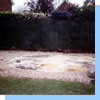
Marking out the excavation
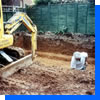
Digging the hole
Step 4: Build the Pool Structure
Now the method undertaken to construct your pool very much depends on the type of pool you are going for, each different pool will have a different set of construction steps. In general, most pools will follow the following steps:
For Concrete Block Pools:
- Lay a concrete foundation (at least 6 inches thick).
- Build reinforced concrete block walls.
- Apply waterproof render and install a vinyl liner or tiles.
For Timber-Framed Pools:
- Construct a strong timber frame.
- Line the inside with marine-grade plywood and a waterproof membrane.
- Install a pre-made pool liner to hold water.
In the case of our case study pool, the construction team worked through the following steps:

Bottom channel goes down straight on top of the dig
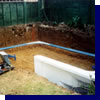
Panels placed in bottom channel and walls erected
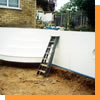
Step unit is cam-locked to the pool shell
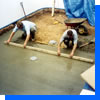
Pool bottom screeded – note main drains protruding at ground level
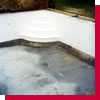
Screeded floor completed
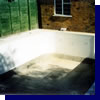
Behind the pool panels is then backfilled
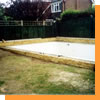
Pool surround is erected
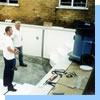
25mm Polystyrene applied to screeded floor
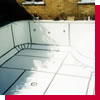
Completed floor covering
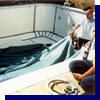
Liner is placed at the bottom of the pool
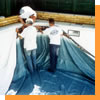
Liner is locked into place
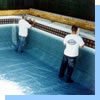
Pool liner is vacuumed back to pool sides removing all creases

Liner is gathered around the corner step unit
Step 5: Install Filtration and Plumbing
To keep your water clean and safe, the next stage is to then install any and all water filtration systems that were supplied with your pool kit. Again, if you are using a contractor they will undertake roughly the following steps:
- A pool pump and filter system (sand or cartridge filter).
- A chlorine or saltwater system for disinfection.
- Proper drainage pipes to prevent waterlogging.
Step 6: Fill and Maintain Your Pool
Once construction is complete:
- Fill your pool with clean water (consider using a pool water delivery service for faster filling).
- Test and adjust chemical levels to maintain safe water quality.
- Regularly clean filters, skimmers, and pool surfaces to prevent algae growth.
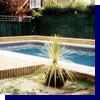
Pool is filled and decking surround added
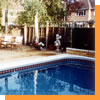
Swimming pool project complete!
As or example above is a case study, the owner of the property Gary made the following comments about the particular pool he had chosen and how it was constructed.
The system was explained to me along with the fact that I would receive technical support from the suppliers of the pool. The benefits of the system we went with from Pollypool outweighed any other presented to me by other companies I had contacted about this project.
I’m an engineer myself and did spend a lot of time studying the concept of the Polypool system.
The first thing that struck me was the way it all went together. It was very straight forward. I employed the services of a few good friends and took my time. Whenever I had some spare time, I would do a little bit more. This whole job was completed mainly at week-ends and evenings.
I brought in contractors to excavate, put the panels in, screed the floor and fit the liner. In hindsight I needn’t have done that.
The bottom channel system and the panels went in no time and had I known how simple it was I would have done it myself.
I was asked to work out how many man-hours the job took and to calculate the overall cost of the pool including the kit, the raw materials and any additional labour supplied by my contractors. I would just like to add that building this pool myself not only saved me a lot of money but also gave me a lot of satisfaction.
The long-term benefit for me is that the running costs are already proving to be far lower than they would have been without the heat retention Polypool offered me. After one season, I estimate that the pool has cost us £500 to run including heating and chemicals etc.
The family have had a lot of fun in and around the pool and it’s one of the best things I’ve ever bought after my house and my car.
As we have commented, the above is only a rough run through on the method that is usually undertaken by a contractor when constructing a swimming pool, however they can vary greatly due to the variety of different pools and how each individual is constructed.

